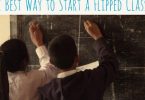--Originally published at FLN Hub – nodes
Hybrid Pedagogy is a publication you should be reading. It's completely open access, written, edited, and published by educators. The article authors and editors are laser focused on the deeper questions within technology use in education like innate power structures, programmed bias, and the fact that technology is not agnostic by nature.
This week I read Beyond Surface-Level Digital Pedagogy and was introduced to HybridPod, a companion podcast to Hybrid Pedagogy. The article linked and Martha Burtis' keynote at the 2016 Digital Pedagogy Institute really push hard on the idea that all instructors and all students should really be doing stuff on the web. Learning stuff. Breaking stuff. Just stuff.
Tying the two together is this idea (posited in the first article):
"...if our institutions of higher learning ignore the calls for critical digital pedagogy a vast number of K-12 educators will continue to look for shiny tools to cover up education’s most difficult problems."
Granted, higher education has been involved in the making (and breaking) of the web since the beginning while K-12 has really started using it in earnest with students in the last ten years. There's history there, in higher ed, that isn't present in K-12. But, are we learning lessons from that history?
In particular, have K-12 teachers really recognized the enormous value in making and sharing things online? I'm not convinced that lesson is one that's been learned, nor is it one people want to learn. Martha's discussion of the LMS is describing the current state of K-12 education:
I think the Web hit us at a critical moment in higher education where we were already struggling with doing our work less like schools and more like businesses, and the tech industry and its vendors had already begun to infiltrate us with promises of how technology could help us achieve this goal. We had already bought into student information systems (which eventually became everything information systems), and with the promise of those systems came the promise of lots of data which would allow us to become more efficient and streamlined.
As the web becomes more sterilized for our students, we have important pedagogical decisions to make.
Flipped Learning, given its popularity, is often the first place teachers are confronted with working heavily in the online space. Many are already constrained to the LMS and find the shortcomings frustrating to work within. So, they work around.
That process of working around limitations exposes teachers (and by extension, students) to the potential of working in an open web space rather than a closed web space. Flexibility and customizability become the expectation rather than the "nice-to-have." And it's not just about the look of the space: flexibility in functionality - the experience students have - can strongly influence their experience in learning (it's a hybrid experience, remember?)
I agree that Flipped Learning, at first does not necessarily push a shift in instructional methods. But, when you're used to teaching in a very straightforward manner, whether in person or online (in an LMS, perhaps) making an instructional shift is very difficult because of the mindset change involved. I'd like to propose that the first shift be to look outside the provided methods of organization and begin to explore the messiness of digital learning through open spaces.
Martha's suggestion is simple: set up, and run, a domain. The easiest thing to do is purchase a domain name and start a blog. Start sharing. Start reading. Reflecting on practice in an open environment invites comment and outside input to your pedagogy. Being transparent and vulnerable in what we do with instruction will begin to inform those instructional decisions and help bring about a shift.
As you get more comfortable with your space, you'll feel more comfortable pushing your students to do the same. Our students are creating digital footprints in spaces where there is no control. In schools, it's in the LMS. Outside of school, it's through social media (no, they do not own their tweets, snaps, or likes).
Improving in the use of technology is more than just being able to whip out the right app at the right time. It's being able to critically pick apart the explicit and implicit nuance in function while at the same time enhancing the learning experience. Use the challenge of flipping to really push your thinking about how technology can truly change the teaching and learning experience in schools.
flickr photo shared by AstridWestvang under a Creative Commons ( BY-NC-ND ) license





